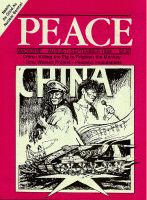
Peace Magazine Aug-Sep 1989, page 21. Some rights reserved.
Search for other articles by Cesar A. Chelala MD here
The U.S. Administration and Congressional leaders have agreed to continue aid to the Nicaraguan guerrillas. This is a poor response to the peace accord signed by the five Central American presidents in El Salvador. Because it perpetuates mistrust that can only prolong war, instability, and further emigration of desperate refugees, it is the wrong approach even for the U.S.'s long term interests in the region.
The most hideous consequences of more than a decade of warfare in Central America have been the dead, maimed and displaced people, and a staggering number of orphans - an estimated 100,000 in Guatemala alone - in all countries involved in the conflict. Hundreds of medical facilities, ranging from basic health posts in rural areas to complex hospitals in cities, have been ruined.
El Salvador, although the fifth largest recipient of U.S. aid in the world, still has a very high infant morality rate: 67.7 out of every 1000 babies die before celebrating their first birthday. Twenty-seven percent of Salvadorean children under the age of five suffer from malnutrition. According to statistics from an American medical delegation to El Salvador, in the village of San Jose las Flores, 43 percent of deaths among children were due to army violence.
In El Salvador alone 70,000 have been killed since 1979 - over a hundredth of the whole population. During the same period over one million people have become refugees.
In Guatemala, warfare and economic deterioration have claimed between 50,000 to 75,000 lives since late 1970s. Although most of the deaths were the result of war-related violence, a significant proportion was due to malnutrition and sickness. Data from national nutrition surveys indicate that the nutritional status of rural children under 5 years of age has not improved in 20 years.
The war waged by the Contras has forced Nicaragua to increase the defence expenditures from 18.2 percent of the total budget in 1982 to 46.3 percent in 1987. Correspondingly, this has reduced allocations for social and health services. Sixty-five health care units have been destroyed by the Contras and 37 have been closed due to the threat of Contra attacks, thus eliminating health coverage to more than 30,000 people.
Disruption of measles immunization campaigns has led to serious outbreaks of measles. In areas not affected by war, malaria has diminished dramatically. In war zones, however, it has increased, following disruption of malaria campaigns. Massive population displacements have led to increased undernutrition, especially noticeable among children under the age of five.
Hondurans have suffered in terms of health and environment. Mortality rates continue to be the highest in the region. There has been an increase in sexually transmitted diseases - including penicillin-resistant gonorrhea - in areas near military bases.
Teachers near Palmerola, the largest U.S. military base in Honduras, report the presence of venereal disease sores in elementary school children. Dr. Juan Almendares, a former dean of the Medical School and Rector of the National Autonomous University of Honduras, estimates that the incidence of AIDS is the highest in Central America.
This dismal picture of the war-torn Central American countries is in stark contrast to the situation in peaceful Costa Rica. This country has not totally escaped the pernicious effects of war in neighboring countries. Its health status indicators, however, are still the best in Central America and among the best in the whole hemisphere. It has set an example of peace and prosperity that should be emulated by its neighbors.
The U.S. should continue dialogue with the Soviet Union on foreign intervention in the region. And it should begin rebuilding the destroyed health infrastructure in all these countries.
These actions could be accompanied by measures to speed up economic recovery in the area. They are set out in detail both in the International Commission for Central American Recovery and Development (Stanford Commission) report and in the United Nations "Special Plan for Economic Cooperation for Central America." This would revitalize the role of Central America as a U.S. trading partner and, by creating new job opportunities, would diminish the influx of refugees to the United States. The resulting trust and cooperation would be a base to build lasting peace in the area.
Dr. Cesar A. Chelala, an Argentine medical scientist, writes frequently on international issues.

Peace Magazine Aug-Sep 1989, page 21. Some rights reserved.
Search for other articles by Cesar A. Chelala MD here